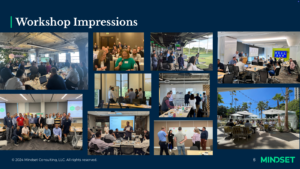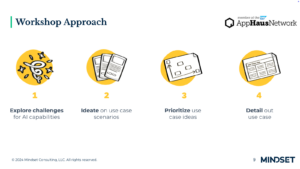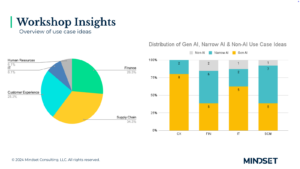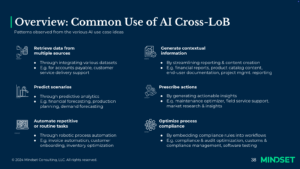Artificial intelligence is not a substitute for human intelligence; it is a tool to amplify human creativity and ingenuity.” —Fei-Fei Li
This quote by Fei-Fei Li, the “AI Godmother,” hits home as the whole world is bearing witness to the rapid progress and many promises of AI, particularly among businesses. The true potential of AI, however, lies not just in its technology but in how it is applied to improve human experiences. Our SAP x Mindset AI Workshop Series, ten events conducted across eight U.S. cities, focused on this very approach—human-centered AI (HAI)—to explore innovative AI use cases for businesses that run SAP technology.
The workshop series, a collaboration between Mindset and SAP, brought together over 340 participants from 125 companies from various industries to ideate on AI use cases that solve real business challenges. We’ll highlight the insights, results, and key takeaways from the series, and explore how organizations can embrace HAI for transformative business outcomes.

In this first part of our exploration into HAI, we dive into the core insights and outcomes from our SAP x Mindset AI Workshop Series. We’ll outline how we conducted our HAI use case exploration workshops, an overview of the resulting use case ideas, as well as patterns of use cases that emerged from the sessions. From understanding the importance of efficiency and automation to recognizing when AI is truly necessary, this article lays the foundation for leveraging AI to drive meaningful business transformation.
The Workshop Series Overview
Our motivation for kicking off the workshop series came from a place of genuine curiosity. We wanted to know: What are the most pressing business challenges that could be solved with AI? The series spanned 10 workshop sessions across Minneapolis, Atlanta, Dallas, Houston, Chicago, Detroit, Columbus, and Newport Beach. The intent of the workshops aimed at:
- Ideating on Generative AI (Gen AI) use cases with a human-centric approach
- Fostering collaboration among business and IT stakeholders to tackle shared challenges with AI
Being a member of SAP AppHaus, a global network of selected innovation partners that are focused on human-centered design, we utilized and adapted the toolkit for SAP Business AI Explore Workshop (illustrated in Figure 2). Throughout the sessions, participants were encouraged to explore the intersection of technology, human needs, and business value, ensuring that AI solutions are not only effective but also beneficial to employees, customers, and relevant stakeholders.

Workshop Results
The workshops resulted in 149 use case ideas across various business functions. Most of them were in Supply Chain (34.3%), followed by Finance (26.3%), Customer Experience (25.3%), IT (8.1%) and Human Resources (6.1%). We then consolidated duplicated ideas and ended up with 10 use cases in Customer Experience (SCM), 13 in Finance, 8 in IT, and 13 in Supply Chain Management (SCM). For the moment, we parked Human Resources as we wanted to focus on the top 3 business functions in addition to IT use cases.

In analyzing the application of AI in those use cases, it became clear that not all use cases necessitated Gen AI – there were use cases that utilized Narrow AI (difference explained here), and some did not even need AI, to which we categorized as non-AI use cases. Figure 3 shows the distribution of use cases and their respective categorization. We will highlight the top AI use cases next.
Common Use of AI: Patterns Across Enterprise Functions
We observed six distinct patterns on how AI can transform business operations:
- Retrieving data from multiple sources integrates datasets for better insights in processes like accounts payable and customer service.
- Generating contextual information streamlines reporting and content creation, improving decision-making across functions.
- Predicting scenarios with AI helps forecast financial trends and production needs,
- Prescribing actions offers actionable insights for maintenance optimization, market research, and field service support.
- Automating repetitive tasks like invoice processing and onboarding boosts efficiency.
- Optimize process compliance by embedding compliance rules into workflows, ensuring regulatory adherence.

The different use of AI in Figure 4 exists today through various SAP capabilities, whether that is through Joule or Embedded Capabilities, AI Foundation on SAP Business Technology Platform, or through various partners of SAP’s AI ecosystem. However, in line with Mindset’s human-centric approach, we believe that these capabilities would yield value when they are based on the needs of the business, with emphasis on the end-users. To that end, in Part 2 of this blog series, we will dive deeper into the common business challenges and specific AI use cases across key business functions such as Customer Experience, Finance, Supply Chain, and IT. Stay tuned for the second article, where we describe how AI combines several capabilities to produce an even more impactful outcome in enabling business transformations.
In the meantime, check out our full report here and contact us to learn more about how we can help you identify and prioritize high-value AI use cases, and how the interdependence of AI with SAP technologies can propel your team and organization as a whole, in becoming an innovative, future-ready enterprise.